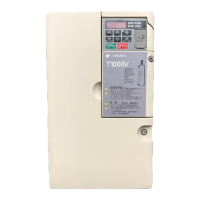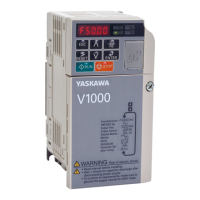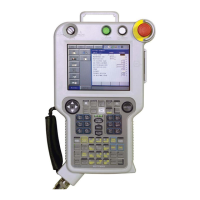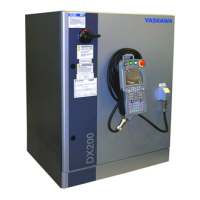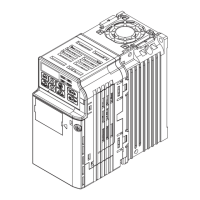5.4 d: Reference Settings
YASKAWA ELECTRIC SIEP C710616 30B YASKAWA AC Drive T1000A Technical Manual 159
Parameter Details
5
Input Value Polarity
The polarity of the torque reference determines the direction of the torque output from the motor, and is not determined
by the direction of the Run command (i.e., forward or reverse). The polarity of the torque reference depends on the
following:
Positive torque reference: Drive’s internal torque reference is for forward operation (rotating counter-clockwise when
looking down the motor shaft from the load side).
Negative torque reference: Drive’s internal torque reference is for reverse operation (rotating clockwise when looking
down the motor shaft from the load side).
When using an analog signal to set the frequency reference, the following situations will create a negative input signal:
• Negative voltage reference input
• Positive voltage reference input but using a negative value for the analog input bias
• Positive voltage reference input with an input terminal set to “External torque reference polarity inversion” (H1- =
78) is closed
The sign for the torque reference (positive or negative) can also be set using MEMOBUS/Modbus or a communications
option card.
n
Speed Limitation and Speed Limit Bias
The speed limit setting is read from the input selected in parameter d5-03. A bias can be added to this speed limit using
parameter d5-05 while parameter b5-08 determines how the speed limit bias is applied. Table 5.18 explains the relation
between these settings.
Table 5.18 Speed Limit, Speed Bias and Speed Limit Priority Selection
Torque Compensation
Analog inputs A1/A2/A3 H3-02, H3-10, or H3-06 = 14
<1>
Make sure the signal level settings for the input terminal selected
match the signal used. Refer to H3: Multi-Function Analog Inputs
on page 201 for details on adjusting analog input signals.
Analog Option Card
• F2-01 = 0
• H3-02, H3-10, or H3-06 = 14
<1>
The H3- settings become effective for the option board input
terminals. Make sure the signal level settings for the input terminal
selected match the signal used.
MEMOBUS Register 0005h
• b1-01 = 2
• Set Register 000Fh, bit 3 = 1 to enable the torque
compensation setting by register 0005h
–
Communication Option Card
b1-01 = 3
Refer to the option card manual for details about
setting the torque reference value.
–
<1> Sets analog input terminals A1, A2, and A3 to supply the speed limit, torque reference, or torque compensation. An operator programming error
oPE07 (Multi-Function Analog Input Selection Error) will occur if two analog inputs are set for the same function.
Operating Conditions
Run Command Forward Reverse Forward Reverse Forward Reverse Forward Reverse
Torque Reference
Direction
Positive (Forward) Positive (Reverse) Negative (Reverse) Negative (Forward) Negative (Reverse) Negative (Forward) Positive (Forward) Positive (Reverse)
Speed Limit
Direction
Positive (Forward) Negative (Forward) Negative (Reverse) Positive (Reverse) Positive (Forward) Negative (Forward) Negative (Reverse) Positive (Reverse)
Normal Operation
Direction
Forward Reverse Forward Reverse
Generated Torque
(d5-08 = 0)
<1>
Input Value Signal Source Settings Remarks
Speed
Torque
Torque
Limit
Internal
Torque
Reference
0
Torque
Limit
Speed
Limit
Δn
Speed Limit
Bias d5-05
Speed Limit
Bias d5-05
Speed
Torque
Torque
Limit
Internal
Torque
Reference
0
Torque
Limit
Speed
Limit
Δn
Speed Limit
Bias d5-05
Speed Limit
Bias d5-05
Δn
Speed
Torque
d5-05
Torque
Limit
Internal
Torque
Reference
0
Torque
Limit
Speed Limit
Δn
Speed Limit
Bias d5-05
Speed
Torque
Torque
Limit
Internal
Torque
Reference
0
Torque
Limit
Speed
Limit
Speed
Limit Bias
d5-05
Δn
Δn
Speed
Limit Bias
d5-05

